Ethiopia–Yugoslavia relations
Ethiopia–Yugoslavia relations were historical foreign relations between Ethiopia and now split-up Socialist Federal Republic of Yugoslavia. Both countries were among founding members of the Non-Aligned Movement. The first contacts between the two countries were established at the United Nations in 1947 where Yugoslavia supported Ethiopian claims on Eritrea (the end of the British Military Administration and the establishment of the Federation of Ethiopia and Eritrea) while Ethiopia supported Yugoslav claims over the Free Territory of Trieste.[1] After the 1948, Tito-Stalin split Yugoslavia turned towards the non-bloc countries and two countries opened their embassies in 1955.[1] The formal diplomatic relations were established already in 1952.[2] Emperor Haile Selassie was the first African head of state in official visit to Yugoslavia in 1954.[1]
Ethiopia |
Yugoslavia |
|---|---|
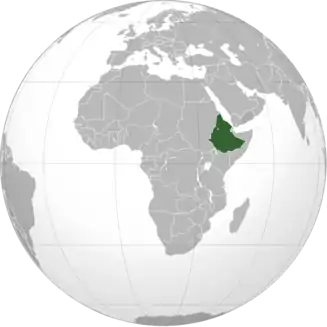
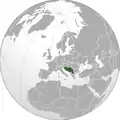
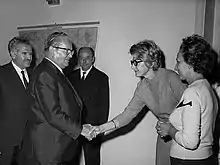
During Tito's visit to Ethiopia in 1970 (part of a tour to Tanzania, Zambia, Ethiopia, Kenya, Sudan, United Arab Republic and Libya) president and emperor of Ethiopia discussed their aims within the Non-Aligned Movement and expressed satisfaction with the fact that the Nigerian Civil War was over in which the Organisation of African Unity played prominent positive role.[3]
Cultural exchange
The two countries ratified their program of cultural collaboration in 1965.[4] Yugoslav exhibition of frescoes copies from the Our Lady of Ljeviš Serbian Orthodox church was sent to Addis Ababa in 1967.[4] In 1977 Belgrade organized another exhibition of Yugoslav photography in Addis Ababa with over 100 exhibits represented the period of the National Liberation War and Socialist Revolution during the World War II in Yugoslavia.[4]
List of bilateral state visits
Yugoslav visits to Ethiopia
- 11-24 December 1955: Josip Broz Tito[5]-Yekatit 12 monument
- 2-12 February 1959: Josip Broz Tito[5]
- 27 January-4 February 1968: Josip Broz Tito[5]
- 9-11 February 1970: Josip Broz Tito[5]
Ethiopian visits to Yugoslavia
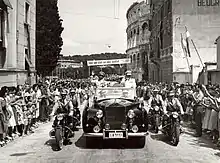
- 20-26 July 1954: Haile Selassie[5]
- 15-24 August 1959: Haile Selassie[5]
- 2-4 November 1963: Haile Selassie[5]
- 29 September 1964: Haile Selassie[5]
- 26-27 October 1966: Haile Selassie[5]
- 4-5 July 1967: Haile Selassie[5]
- 23-25 September 1968: Haile Selassie[5]
- 25-30 June 1972: Haile Selassie[5]
- 30-31 October 1973: Haile Selassie[5]
- 7-10 December 1978: Mengistu Haile Mariam[5]
See also
- Yugoslavia and the Non-Aligned Movement
- Yugoslavia and the Organisation of African Unity
- Ethiopia–Serbia relations
- Museum of African Art, Belgrade
- Archives of Yugoslavia
- Yekatit 12 monument
- Italian Ethiopia
- Invasion of Yugoslavia
- Italian governorate of Montenegro
- Italian protectorate of Albania (1939–1943) (including parts of Yugoslavia)
- Death and state funeral of Josip Broz Tito
References
- Savić, Miloš (2018). Етиопска револуција и смрт Хајла Селасија у југословенској спољној политици (1973-1978) (PDF) (Master Thesis). University of Belgrade. Retrieved 2 November 2020.
- Radina Vučetić; Pol Bets; Radovan Cukić; Ana Sladojević (2017). Tito u Africi: slike solidarnosti (PDF). Museum of Yugoslavia. ISBN 978-86-84811-45-7.
- Milutin Tomanović, ed. (1971). Hronika međunarodnih događaja 1970. Institute of International Politics and Economics. p. 2228.
- Teja Merhar (2019). "International Collaborations in Culture between Yugoslavia and the Countries of the Non-Aligned Movement". In Tamara Soban (ed.). Southern Constellations: The Poetics of the Non-Aligned (PDF). Museum of Modern Art (Ljubljana). pp. 43–70. ISBN 978-961-206-138-8.
- R. Radonić, Nemanja (2020). Слика Африке у Југославији (1945-1991) (PDF) (Doctoral Thesis). University of Belgrade. Retrieved 1 November 2020.
External links
- Florian Bieber & Wondemagegn Tadesse Goshu (2019). Don’t Let Ethiopia Become the Next Yugoslavia. Foreign Affairs.
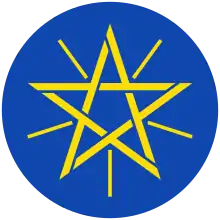
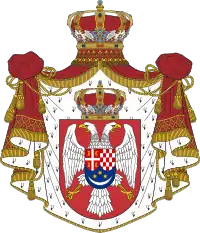
.svg.png.webp)